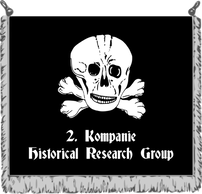Insignia of the SS-Totenkopfdivision
Pre-War Period (1937-1939)
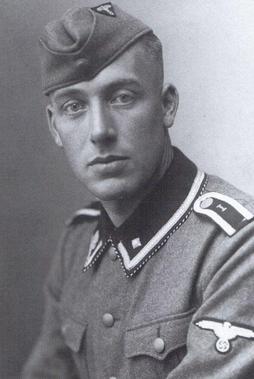
Before the SS-Totenkopfdivision existed, the cadre that would make it up would come from three SS-Totenkopfstandarten, which guarded camps in Germany. These units wore the same uniforms and insignia as the normal SS, with exception to wearing a skull on their collar instead of SS Runes.
The first collar tabs worn by the men in these units featured a number below the skull, which represented the company. The numbered collar tabs would not be seen when the division was formed in 1939.
The men wore pointed style shoulderboards until 1939, and also typically featured the number of the regiment the soldier served. On enlisted men this number was embroidered into the shoulder board, and for senior NCO and officers, this number was cypher, worn in the middle.
These early formations also were issued cufftitles. SS-Totenkopfstandarten 1. 'Oberbayern' wore a cufftitle featuring a simple skull in the center. This cufftitle was popular in the division, and continued to be seen throughout the war.
The first collar tabs worn by the men in these units featured a number below the skull, which represented the company. The numbered collar tabs would not be seen when the division was formed in 1939.
The men wore pointed style shoulderboards until 1939, and also typically featured the number of the regiment the soldier served. On enlisted men this number was embroidered into the shoulder board, and for senior NCO and officers, this number was cypher, worn in the middle.
These early formations also were issued cufftitles. SS-Totenkopfstandarten 1. 'Oberbayern' wore a cufftitle featuring a simple skull in the center. This cufftitle was popular in the division, and continued to be seen throughout the war.
Early War Period (1940-1942)
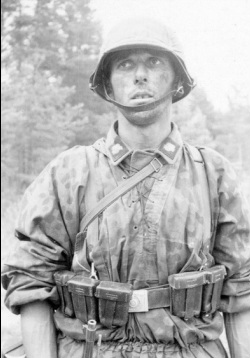
The three original SS-Totenkopfstandarten were formed into a division in 1939 following the invasion of Poland. Along with these men, the division received an influx of new recruits and men from the SS-VT.
The insignia worn by the early Totenkopfstandarten continued to be worn by some members of the division, and the pointed style shoulder boards continued to be seen on NCO's until 1943. The skull cuff title was seen as a status symbol, and since the division was not authorized a cuff title yet, it was the only cuff title worn, although it was not worn by everyone.
In 1940, the men of "Totenkopf" began wearing what we call "mirrored" collar tabs, which were collar tabs featuring a "Totenkopf" on both sides, instead of only on the right and rank on the left.
These were worn all the way through Operation Barbarossa and the Totenkopfdivision's first tour in Russia. These fell out of use by 1943, because you can not tell the rank of a soldier when wearing a smock.
The insignia worn by the early Totenkopfstandarten continued to be worn by some members of the division, and the pointed style shoulder boards continued to be seen on NCO's until 1943. The skull cuff title was seen as a status symbol, and since the division was not authorized a cuff title yet, it was the only cuff title worn, although it was not worn by everyone.
In 1940, the men of "Totenkopf" began wearing what we call "mirrored" collar tabs, which were collar tabs featuring a "Totenkopf" on both sides, instead of only on the right and rank on the left.
These were worn all the way through Operation Barbarossa and the Totenkopfdivision's first tour in Russia. These fell out of use by 1943, because you can not tell the rank of a soldier when wearing a smock.
Late War Period (1943-1945)
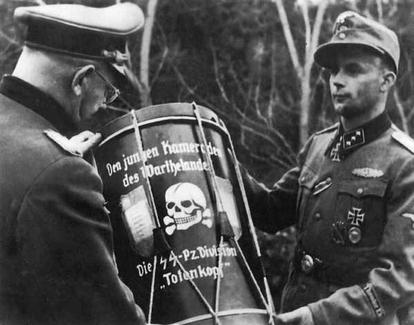
During this period, the entire division was authorized a cuff title which just said "Totenkopf" in plain letters. These were most common in the Panzergrenadier Regiments.
Men also began to be issued the "horizontal" style of collar tab.
The pointed style of shoulder board, the "Oberbayern" cuff title and the mirror collar tabs all ceased to be worn.
In 1943, SS-Panzergrenadier-Regiment 6, was given the honor title "Theodor Eicke" after it's commander was killed in Russia. This regiment was authorized a cuff title which said "Theodor Eicke" in simple letters.
Men also began to be issued the "horizontal" style of collar tab.
The pointed style of shoulder board, the "Oberbayern" cuff title and the mirror collar tabs all ceased to be worn.
In 1943, SS-Panzergrenadier-Regiment 6, was given the honor title "Theodor Eicke" after it's commander was killed in Russia. This regiment was authorized a cuff title which said "Theodor Eicke" in simple letters.
Shoulder Boards
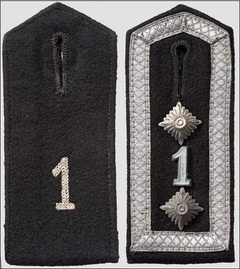
Pictured left are two different shoulderboards as worn by the men of SS-Totenkopfstandarten 1. 'Oberbayern'. The boards were worn by the members of the Totenkopfdivision who were cadre, and former members of this unit.
This style of shoulder board was used by all the SS during the pre-war period and did not have trim. Ours have a 1, for the regiment.
The board on the left is for an enlisted man, a Schutze through Rottenfuhrer.
This style of shoulder board was used by all the SS during the pre-war period and did not have trim. Ours have a 1, for the regiment.
The board on the left is for an enlisted man, a Schutze through Rottenfuhrer.

In 1939 and 1940, this style began to replace the style above.
These featured piping around the sides, which would be in different colors, known as 'waffenfarbe'. White, as pictured is for Infanterie, which is what our unit represents.
These featured piping around the sides, which would be in different colors, known as 'waffenfarbe'. White, as pictured is for Infanterie, which is what our unit represents.
Collar Tabs
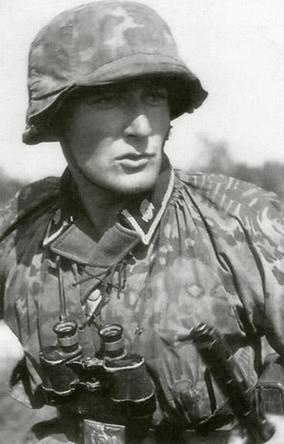
When Theodor Eicke was given command of his own division, he adopted the insignia of the SS-Totenkopfverbande for his new unit. He was formerly the commander of the SS-Totenkopfverbande, which were in charge of the camps. This association would forever haunt the division.
Instead of wearing standard SS rune collar tabs, the men of the Totenkopfdivision wore collar tabs featuring the Totenkopf insignia. These came in two variations, known as "vertical" and "horizontal". The vertical style collar tabs were issued earlier than the horizontal style.
From 1940-1942, some men in the division wore "mirrored" collar tabs, which featured the Totenkopf on both sides. However, these were eventually phased out because you could not tell rank when the soldier was wearing the smock over his tunic.
The mirrored tabs were very popular among the men, and Totenkopf wore them longer than any other SS Division.
By 1944, the mirror collar tabs were gone, and most men were issued "horizontal" style collar tabs.
Instead of wearing standard SS rune collar tabs, the men of the Totenkopfdivision wore collar tabs featuring the Totenkopf insignia. These came in two variations, known as "vertical" and "horizontal". The vertical style collar tabs were issued earlier than the horizontal style.
From 1940-1942, some men in the division wore "mirrored" collar tabs, which featured the Totenkopf on both sides. However, these were eventually phased out because you could not tell rank when the soldier was wearing the smock over his tunic.
The mirrored tabs were very popular among the men, and Totenkopf wore them longer than any other SS Division.
By 1944, the mirror collar tabs were gone, and most men were issued "horizontal" style collar tabs.
Cuff Titles
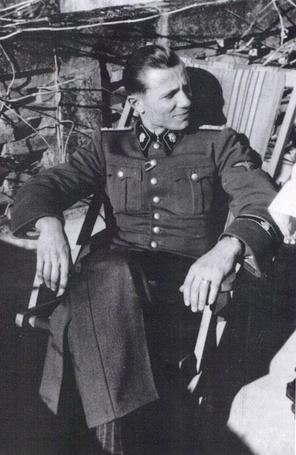
In the early years of the Totenkopfdivision, the men were not issued cuff titles, however, many of the cadre came from SS-Totenkopfstandarten 1. "Oberbayern", which wore a cufftitle featuring a simple skull on it. This cufftitle saw heavy use in the division in the early years, and was even used as a status symbol in the later years for experience and tenure in the division.
In fall 1942, the Division was being re-formed after it was decimated on the eastern front, and men began to wear cuff-titles that said "Totenkopf" in plain letters. These were authorized for the entire Division.
After the Division's first commander was killed in action, and the division was reformed once again in 1943, the SS-Panzergrenadier-Regiment 6, was given the name "Theodor Eicke", in the fallen commanders honor. The men of this regiment were authorized to wear a cufftitle that said "Theodor Eicke" in plain letters.
Many men in the Totenkopfdivision never even wore a cufftitle. They saw their most use among NCO's, Officers, and men serving in the Infanterie or Panzergrenadier Regiments.
In fall 1942, the Division was being re-formed after it was decimated on the eastern front, and men began to wear cuff-titles that said "Totenkopf" in plain letters. These were authorized for the entire Division.
After the Division's first commander was killed in action, and the division was reformed once again in 1943, the SS-Panzergrenadier-Regiment 6, was given the name "Theodor Eicke", in the fallen commanders honor. The men of this regiment were authorized to wear a cufftitle that said "Theodor Eicke" in plain letters.
Many men in the Totenkopfdivision never even wore a cufftitle. They saw their most use among NCO's, Officers, and men serving in the Infanterie or Panzergrenadier Regiments.
